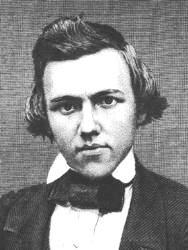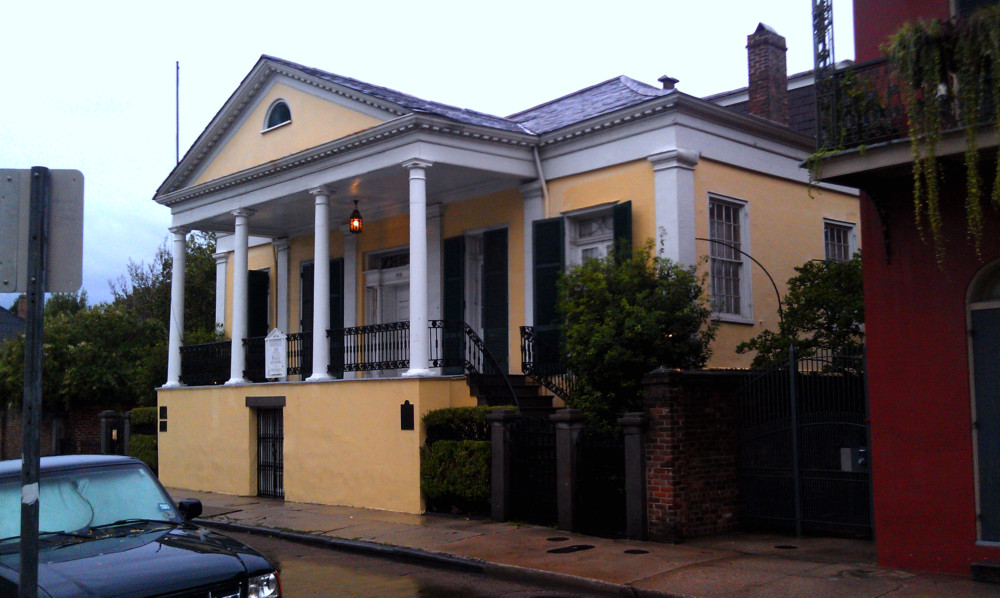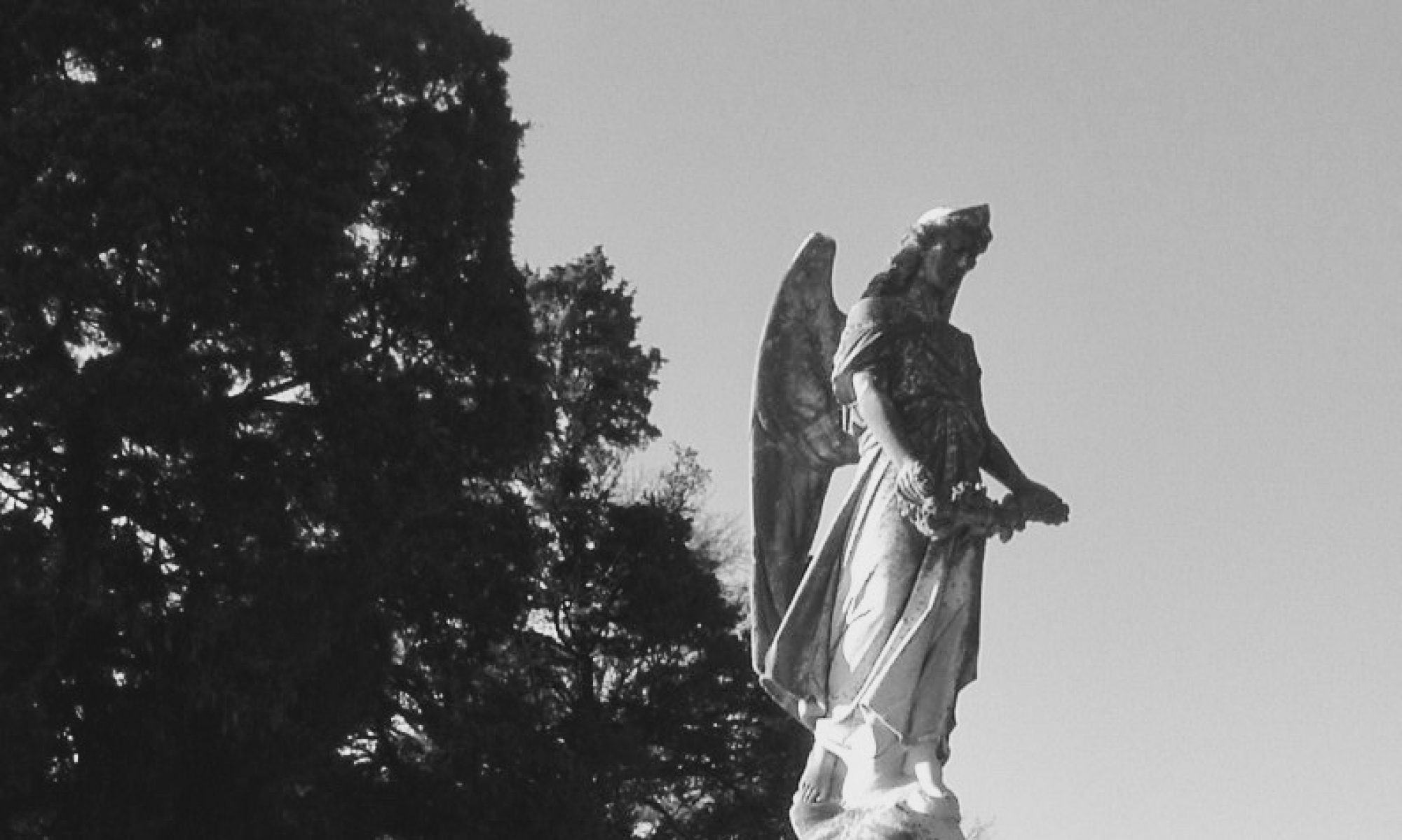Beauregard-Keyes House
1113 Chartres Street
New Orleans, Louisiana
N.B. This article was edited and updated 8 August 2019.
For information on neighboring spirits see my Chartres Street guide and the main page for my Phantoms of the French Quarter series.
The sunny, yellow façade of the Beauregard-Keyes House on a relatively quiet section of Chartres Street does not belie the sometimes tragic history that has taken place within its walls. That quiet demeanor is shattered frequently by tour guides, with gawking tourists in tow, intoning one of the many “legends” about this house as they pass. According to their spiels, the house is inhabited by a pantheon of shades, some quite famous.

General Pierre Gustave Toutant-Beauregard, who occupied the house for about three years following the Civil War, was supposedly haunted by his defeat at the Battle of Shiloh. “…it’s General Beauregard whose presence at 1113 Chartres Street, and whose ghost seems obsessed with returning to the bloody scene of battle that traumatized him for the rest of his life—and beyond.”
Mary Beth Crain in her 2008 book, Haunted U.S. Battlefields continues, “In 1893, the year of the general’s death, people walking by the house late at night reported hearing ‘the voice.’ Someone seemed to be gasping ‘Shiloh…Shiloh’ over and over in a raspy chant that sounded as if it were coming from a great distance…Who else could ‘the voice’ belong to but General P.G.T. Beauregard, the man who throughout his life was haunted by the demons of the battle he needlessly lost? …There was terror in that one word, a sense of horror that was so convincing, those who heard it bolted as fast as they could.”

A Haunting Battle
For a name that is Hebrew for “place of peace,” Shiloh, Tennessee is associated with the stench of death and quite possibly haunted Beauregard after his defeat there. The battle, fought in early April, 1862, is often described as the first of the many bloody battles that would be fought during the Civil War.
Union troops under General Ulysses S. Grant were encamped on the banks of the Tennessee River near Pittsburg Landing, Tennessee, while some twenty-odd miles away Confederate troops under General Albert Sidney Johnston and Beauregard, his second in command, were camped at Corinth, Mississippi. Union reinforcements under General Don Carlos Buell were expected to arrive from Columbia, Tennessee after which Grant would sweep down into Mississippi to begin slow disemboweling the Confederacy. Johnston, over Beauregard’s objections, aimed at attacking Grant’s forces before Buell’s arrival. Beauregard bowed to Johnston’s commands and prepared a battle plan along the lines of Napoleon’s advance at the Battle of Waterloo. Coincidently, Beauregard, due to his short stature and French heritage was known as “The Little Napoleon.”
The first assault hit the Union camps around 9:30 on the morning of April 6. Union troops were taken by surprise in the middle of breakfast as Confederate troops charged into their camps bearing the red battle flag emblazoned with the blue, starred St. Andrews Cross that had been designed by Beauregard. Many troops on both sides along the three-mile battle line were still green, and scared by the ferocity of battle, fled, with many of the Union troops fleeing towards the safety of the Tennessee River where they cowered under the bluffs. But one Union line held: composed mainly of Illinois and Iowa farmers. This line, along a sunken road through thick woods and a peach orchard under the command of Brigadier General Benjamin M. Prentiss, kept the Confederates at bay for some six hours. They endured charge after charge and almost point blank artillery fire. General Johnston led the final Confederate charge when a bullet severed his femoral artery from which he died a short time later. Command then passed to Beauregard.

Prentiss’ division maintained their position along the sunken road where the ferocity of fighting was dubbed “The Hornet’s Nest.” Confederates surrounded the area on three-sides and they massed artillery onto the position, pouring volley upon volley of cannon-fire onto the Union troops. At 5:30 in the afternoon, Prentiss and his remaining 2,200 troops surrendered. The remaining Yankees had been pushed back to the Tennessee. Surveying the situation, Beauregard surmised that he could easily wipe out the remaining troops the following morning.
The sun rose the next day on a Federal force of nearly 50,000 as Buell’s reinforcements had arrived during the night. This huge force now faced Beauregard’s 30,000 troops. Slowly but surely, Union forces sliced into the Confederates with the troops falling back all the way to Corinth, Mississippi. The battlefield was thoroughly littered with the dead and dying, more than had ever been killed in any war previously fought by the United States: some 3,477 dead with some 23,000 wounded.
Historian Shelby Foote described the battle as “a disorganized, murderous fistfight of one hundred thousand men slamming away at each other.” It was this murderous and costly battle that sickened Beauregard so that he took immediately sick leave without permission of Jefferson Davis, who demoted him. Grant’s responsibility in the blood bath led to his being replaced by General Henry Wager Halleck.
Beauregard’s Haunting Legacy
After losing his military rank, Beauregard’s rank was restored and he went on to serve admirably through the end of the war. He retired to the house in New Orleans that now bears his name where his lived quietly for three years. Over time, legend has risen speaking of a more sinister legacy left by Beauregard in the house. Some tenants of the house have spoken of hearing the sounds of battle, perhaps from Shiloh, within and without the house. Even more interesting is the story that tenants being awakened by the sound of battle have stepped into the ballroom only to walk into the midst of the battlefield of Shiloh. While perhaps the story of the battlefield appearing in the ballroom may be only the product of the story passing through a “multi-generational telephone game.”

House, 2011. Photo by Benjamin Lewis,
all rights reserved,
Of course the lone, contemplative shade of Beauregard has also been reported throughout the house. Jeff Dwyer in his Ghost Hunter’s Guide to New Orleans reports that the General’s spirit has been seen peering out the home’s windows, even seen waltzing with a female, most likely his second wife (his first wife, Marie, died in 1850), Caroline. Interestingly, Beauregard and his wife, Caroline, never lived in the house together. The dashing military man and his bride married in 1860 on the eve of the war. The young couple spent much of the war apart and Caroline died in New Orleans in March of 1864 while it was under Union occupation. After receiving news of his wife’s passing, the stunned Beauregard continued to carry out his duties.
Following the war, without a job, money, or a wife, a chastened Beauregard refused to take the loyalty oath until after he was counseled to do so by his former Confederate peers, Generals Robert E. Lee and Albert Sidney Johnston. He took the oath before the mayor of New Orleans around the time he took up residence in the elegant house on Chartres Street. He was offered positions in the militaries of Brazil, Romania and Egypt but refused the offers saying, “I prefer to live here poor and forgotten, than be endowed with honor and riches in a foreign country.” Perhaps he spent his time in the house in Chartres pining for his darling Caroline and regretting his military blunders, but that is only speculation. Novelist Frances Parkinson Keyes, who lived in the house in the mid-20th century promulgated this mythos in her 1962 novel, Madame Castel’s Lodger. The novel portrays a defeated Beauregard looking back over the remains of his life.
History of 1113 Chartres
Besides it’s three-year occupation by Beauregard, the home possesses quite an illustrious history. Built by Joseph Le Carpentier, an auctioneer, the house was designed by Francois Correjolles incorporated elements of Roman and Greek architecture. Le Carpentier is said to have started his business selling goods for the pirate, Jean Lafitte (who, incidentally, figures into many local ghost stories and legends), and was also grandfather to the master chess player Paul Morphy, who was born in the house.

A few writers mention Morphy among the pantheon of spirits in the house, though much of their information appears to be incorrect. Mary Beth Crain refers to Morphy as “Paul Munni,” though I can’t discern why. It states that he went insane while living in the house. While I have been able to determine that Morphy was in fact born in the house, his mother was Le Carpentier’s daughter, I can find nothing about his residency in the house as an adult. He returned to New Orleans towards the latter part of his life and “retired” from chess, having been victorious over all the world’s chess masters. While I’ve yet to find anything that specifically states that Morphy lost his sanity, he did live his life in seclusion. Morphy died at his home, which is now Brennan’s Restaurant at 417 Royal Street (which has a number of spirits, possibly even Morphy’s), after taking his usual afternoon constitutional and then taking a cold bath.
After leaving the hands of the Le Carpentier family, the house passed through a number of hands including those of Swiss Consul, John A Merle, whose wife created the garden surrounding the house. As the owners changed, the neighborhood changed; filling with Italian immigrants towards the end of the nineteenth century. The house was bought by Sicilian wine merchant, Pietro Giacona in 1904.


Keyes House, 2011. Photo by Benjamin Lewis, all rights reserved.
The Battle of Chartres Street
The Black Hand or La Mano Nero was an extortion racket commonly used among Italians and Italian Americans throughout the nineteenth and into the early part of the twentieth century, when the Mafia took on subtler methods of crime. New Orleans had already seen the tragic effects of such crime in 1890 with the assassination of police chief David Hennessy. The most common modus operandi for The Black Hand was to send the victims a letter, signed with a black handprint, threatening harm unless a specific amount of money was paid.
The Giacona family while living here found themselves victims of The Black Hand, in 1908, after receiving a letter demanding payment of $3000 or certain death. Events reached a zenith in the early morning hours of June 17. When Commander Thomas Capo of the Third Precinct Station arrived at the house around 2:45 AM, he witnessed everything in confusion:
I saw the old man standing on the gallery with the shotgun in his hand, while his son stood almost in the doorway with a rifle in his hands. On the gallery, two of the men were stretched out in death. Their shirts were covered with blood. In the yard, at the foot of the stairs, another man was lying. From its position in the yard, I judged that he was shot while running down the stairs, and had rolled to the ground. The table around which the men were seated before the shooting commenced was littered with watermelon rind and egg shells. Some half-filled wine goblets were also on the table.
A trail of blood led from the yard, over a wall and up and down a number of streets in the area. The trail led to Francisco Vitale who was found wounded at Bourbon and Ursulines Streets.
Pietro Giacona, his son Corrado, and a nephew, Pietro Bellonde, were all arrested for the murders of the Barraca brothers, Giovanni and Nuncy, and Cero Cusimano. Eventually, the Giaconas and the nephew were released. Upon their return, it is said that the house was turned into a fortress. The events of that early June morning were not easily forgotten and may continue to be re-enacted. Reports from people passing the house late at night have included the sounds of gunfire and shouting, the acrid smell of gunpowder and shadowy figures flitting around the fountain in the garden.

When the house was sold in 1925, Antonio Mannino, the new owner considered demolishing the house for either a warehouse or a macaroni factory. This possibility riled local preservationists who were disturbed by the loss of such a landmark. Beauregard House Inc. took over the house and in 1944, the group rented the house to novelist Frances Parkinson Keyes who occupied the house for some 25 years. During this time, she spearheaded a major renovation of the house while writing novels that included the house and former residents. She also created the Keyes Foundation which bought and now operates the house as a museum.
Spiritual remnants from this era may include Mrs. Keyes’ beloved cocker spaniel, Lucky. The dog died only a few days after his mistress’ death. Stories also tell of a large cat that is seen darting through and around the house but then disappearing. The cat is likely the shade of Caroline, a cat that took up in the house museum’s garden. Guests and guides in the house have felt a feline rubbing against their legs.
Though the current directors of the Beauregard-Keyes House deny the existence of spiritual activity in the house, it apparently hosts a legion of spirits. These denials keep investigators at bay, though the city’s many tour operators still walk and drive tourists past the house spinning creepy, and somewhat fictional tales battles on Chartres Street.
Sources
- Battle of Shiloh. Wikipedia, the Free Encyclopedia. Accessed 2 December 2010.
- Bruno, Stephanie. “A House Where the Tall-Tales Are True.” The Times-Picayune. 5 March 2005.
- Crain, Mary Beth. Haunted U. S. Battlefields. Guilford, CT: Globe Pequot Press, 2008.
- “Death of Paul Morphy.” The Daily Picayune. 11 July 1884.
- Dwyer, Jeff. Ghost Hunter’s Guide to New Orleans. Gretna, LA: Pelican Press, 2007.
- Frances Parkinson Keyes. Wikipedia, the Free Encyclopedia. Accessed 23 May 2016.
- “Giacona hearing fixed for Thursday.” The Daily Picayune. 7 July 1908.
- “Giaconas held, but allowed bail.” The Daily Picayune. 10 July 1908.
- “Giaconas held without bond.” The Daily Picayune. 19 June 1908.
- Klein, Victor C. New Orleans Ghosts. Chapel Hill, NC: Professional Press, 1993.
- Paul Morphy. Wikipedia, the Free Encyclopedia. Accessed 2 December 2010.
- G. T. Beauregard. Wikipedia, the Free Encyclopedia. Accessed 2 December 2010.
- Sillery, Barbara. The Haunting of Louisiana. Gretna, LA: Pelican Publishing, 2001.
- Ward, Geoffrey C., Ric Burns and Ken Burns. “A Bloody Affair (1862). The Civil War. American Documentaries, Inc. 1990.
- Ward, Geoffrey C., Ric Burns and Ken Burns. The Civil War: An Illustrated History. NYC: Knopf, 1990.

Hi Michael Bill here. I jave a photo of thhe ghost that haunts the place will you put it on the web site?
I would love to see it and possibly publish it. Send me an email at southernspiritguide@gmail.com.